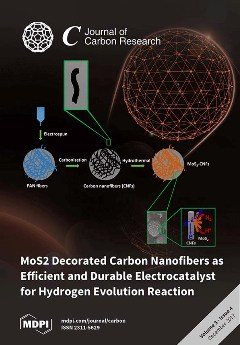Hydrogen is an efficient fuel which can be generated via water splitting, however hydrogen evolution occurs at high overpotential, and efficient hydrogen evolution catalysts are desired to replace state-of-the-art catalysts such as platinum. Here, we report an advanced electrocatalyst that has low overpotential,
[...] Read more.
Hydrogen is an efficient fuel which can be generated via water splitting, however hydrogen evolution occurs at high overpotential, and efficient hydrogen evolution catalysts are desired to replace state-of-the-art catalysts such as platinum. Here, we report an advanced electrocatalyst that has low overpotential, efficient charge transfers kinetics, low Tafel slope and durable. Carbon nanofibers (CNFs), obtained by carbonizing electrospun fibers, were decorated with MoS
2 using a facile hydrothermal method. The imaging of catalyst reveals a flower like morphology that allows for exposure of edge sulfur sites to maximize the HER process. HER activity of MoS
2 decorated over CNFs was compared with MoS
2 without CNFs and with commercial MoS
2. MoS
2 grown over CNFs and MoS
2-synthesized produced about 374 and 98 times higher current density at −0.30 V (vs. Reversible Hydrogen Electrode, RHE) compared with the MoS
2-commercial sample, respectively. MoS
2-commercial, MoS
2-synthesized and MoS
2 grown over CNFs showed a Tafel slope of 165, 79 and 60 mV/decade, capacitance of 0.99, 5.87 and 15.66 mF/cm
2, and turnover frequency of 0.013, 0.025 and 0.54 s
−1, respectively. The enhanced performance of MoS
2-CNFs is due to large electroactive surface area, more exposure of edge sulfur to the electrolyte, and easy charge transfer from MoS
2 to the electrode through conducting CNFs.
Full article





